This article needs additional citations for verification .(March 2013) |
A paint marker is a type of marker pen that is used to create permanent writing on a variety of surfaces such as paper, metal, stone, rubber, plastic, and glass.
This article needs additional citations for verification .(March 2013) |
A paint marker is a type of marker pen that is used to create permanent writing on a variety of surfaces such as paper, metal, stone, rubber, plastic, and glass.
Unlike with most permanent markers the ink is an oil-based paint and generally requires shaking before use, similar to an aerosol spray paint can. In addition, the line is very opaque and, unlike spirit-based or other permanent inks, will not fade with exposure to UV light, and overlays all other colors beneath it. The paint from these types of markers is not truly permanent, as it can be removed using high pressure cleaning or paint thinning solvents such as acetone.
Paint markers, and permanent markers generally, contain the toxic compounds xylene or toluene. Like spray paint, these markers give off volatile organic compounds, which can be dangerous when used in a badly ventilated area or without a particulate mask. Gloves can also be worn to avoid absorption through the skin.
Another type of paint marker is the solidified paint pen. This is a type of marker, often contained within a twist tube, that is a cylinder of semi-hardened oil-paint with a pointed tip. As one writes with it, the point wears down and must be advanced to in order to continue writing. The marker leaves a mark similar to that of chalk. It is useful for marking on wet or oily surfaces. It is sold under the brand name Mean Streak in the United States and generic versions are also available online. [1] It is made by Sanford, the maker of Sharpies, but there are many different brands and types of solidified paint pens. [2]
Paint pens are used for a variety of purposes. Their most general usage is on windows, and they are often used to advertise sales or discounts meant to bring prospective buyers in. Restaurants often hire a professional artist to "paint" with the markers on their windows. Another popular use is for tire lettering, where auto enthusiasts use the markers to customize the look of their tires.
Paint markers have gained more general usage in the arts and crafts community for a variety of uses. These uses include sign design, on photographs in scrap booking, on clothing, glass home goods, as well as traditional art and street art (mainly graffiti). When deciding what to use paint markers for, an artist should also consider this list of qualities of different paint marker brands: removability, odor, pigmentation, and drying time.
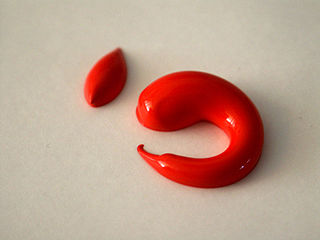
Acrylic paint is a fast-drying paint made of pigment suspended in acrylic polymer emulsion and plasticizers, silicone oils, defoamers, stabilizers, or metal soaps. Most acrylic paints are water-based, but become water-resistant when dry. Depending on how much the paint is diluted with water, or modified with acrylic gels, mediums, or pastes, the finished acrylic painting can resemble a watercolor, a gouache, or an oil painting, or it may have its own unique characteristics not attainable with other media.

Paint is a material or mixture that, when applied to a solid material and allowed to dry, adds a film-like layer. As art, this is used to create an image or images known as a painting. Paint can be made in many colors and types. Most paints are either oil-based or water-based, and each has distinct characteristics.

Printmaking is the process of creating artworks by printing, normally on paper, but also on fabric, wood, metal, and other surfaces. "Traditional printmaking" normally covers only the process of creating prints using a hand processed technique, rather than a photographic reproduction of a visual artwork which would be printed using an electronic machine ; however, there is some cross-over between traditional and digital printmaking, including risograph.

Invisible ink, also known as security ink or sympathetic ink, is a substance used for writing, which is invisible either on application or soon thereafter, and can later be made visible by some means, such as heat or ultraviolet light. Invisible ink is one form of steganography.
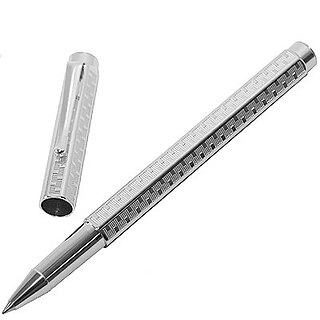
A pen is a common writing instrument that applies ink to a surface, usually paper, for writing or drawing. Early pens such as reed pens, quill pens, dip pens and ruling pens held a small amount of ink on a nib or in a small void or cavity that had to be periodically recharged by dipping the tip of the pen into an inkwell. Today, such pens find only a small number of specialized uses, such as in illustration and calligraphy. Reed pens, quill pens and dip pens, which were used for writing, have been replaced by ballpoint pens, rollerball pens, fountain pens and felt or ceramic tip pens. Ruling pens, which were used for technical drawing and cartography, have been replaced by technical pens such as the Rapidograph. All of these modern pens contain internal ink reservoirs, such that they do not need to be dipped in ink while writing.

A Whiteboard is a glossy, usually white surface for making non-permanent markings. Whiteboards are analogous to blackboards, but with a smoother surface allowing for rapid marking and erasing of markings on their surface. The popularity of whiteboards increased rapidly in the mid-1990s and they have become a fixture in many offices, meeting rooms, school classrooms, public events and other work environments.

A marker pen, fine liner, marking pen, felt-tip pen, felt pen, flowmarker, sign pen, vivid, flomaster, texta, sketch pen, koki or simply marker is a pen which has its own ink source and a tip made of porous, pressed fibers such as felt. A marker pen consists of a container and a core of an absorbent material that holds the ink. The upper part of the marker contains the nib that was made in earlier times of a hard felt material, and a cap to prevent the marker from drying out.

A permanent marker or indelible marker is a type of marker pen that is used to create permanent or semi-permanent writing on an object.
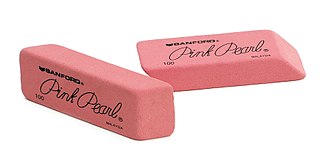
An eraser is an article of stationery that is used for removing marks from paper or skin. Erasers have a rubbery consistency and come in a variety of shapes, sizes, and colors. Some pencils have an eraser on one end. Erasers can come in various shapes and colors. Less expensive erasers are made from synthetic rubber and synthetic soy-based gum, but more expensive or specialized erasers are made from vinyl, plastic, or gum-like materials.
A highlighter, also called a fluorescent pen, is a type of writing device used to bring attention to sections of text by marking them with a vivid, translucent colour. A typical highlighter is fluorescent yellow, with the color coming from pyranine. Different compounds, such as rhodamines are used for other colours.
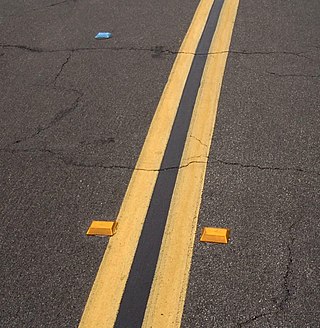
A raised pavement marker is a safety device used on roads. These devices are usually made with plastic, ceramic, thermoplastic paint, glass or occasionally metal, and come in a variety of shapes and colors. Raised reflective markers, such as plastic, ceramic, or metal ones, include a lens or sheeting that enhances their visibility by retroreflecting automotive headlights, while glass road studs gather automotive headlights with a dome shape and reflect the lights with a reflective layer within. Some other names for specific types of raised pavement markers include convex vibration lines, Botts' dots, delineators, cat's eyes, road studs, or road turtles. Sometimes they are simply referred to as "reflectors".

Spray paint is paint that comes in a sealed, pressurized container and is released in an aerosol spray when a valve button is depressed. The propellant is what the container of pressurized gas is called. When the pressure holding the gas is released through the valve, the aerosol paint releases as a fine spray. Aerosol painting is one form of spray painting; it leaves a smooth, even coat, unlike many traditional rolled and brushed paints. Aerosol primer can be applied directly to bare metal and many plastics.
A writing implement or writing instrument is an object used to produce writing. Writing consists of different figures, lines, and or forms. Most of these items can be also used for other functions such as painting, drawing and technical drawing, but writing instruments generally have the ordinary requirement to create a smooth, controllable line.

Powder coating is a type of coating that is applied as a free-flowing, dry powder. Unlike conventional liquid paint, which is delivered via an evaporating solvent, powder coating is typically applied electrostatically and then cured under heat or with ultraviolet light. The powder may be a thermoplastic or a thermosetting polymer. It is usually used to create a thick, tough finish that is more durable than conventional paint. Powder coating is mainly used for coating of metal objects, particularly those subject to rough use. Advancements in powder coating technology like UV-curable powder coatings allow for other materials such as plastics, composites, carbon fiber, and medium-density fibreboard (MDF) to be powder coated, as little heat or oven dwell time is required to process them.

A number of words and phrases that have come to describe different styles and aspects of graffiti and its subculture. Like other jargon and colloquialisms, some of these terms may vary regionally, taking on different meanings across different cities and countries. The following terminology originates primarily in the United States.
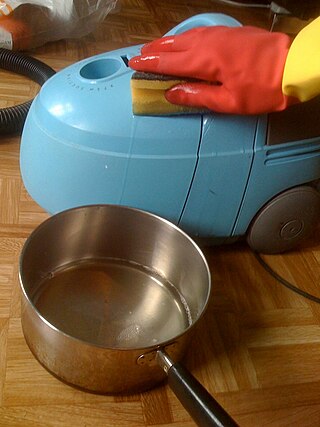
Cleaning agents or hard-surface cleaners are substances used to remove dirt, including dust, stains, foul odors, and clutter on surfaces. Purposes of cleaning agents include health, beauty, removing offensive odors, and avoiding the spread of dirt and contaminants to oneself and others. Some cleaning agents can kill bacteria and clean at the same time. Others, called degreasers, contain organic solvents to help dissolve oils and fats.
Wet-wipe markers or wet-erase markers are a type of writing implement, which are used primarily on overhead transparencies, tablets at restaurants, and office calendars. Other uses include writing on mirrors, chalkboards, plastics, ceramics, glass windows and other non-porous surfaces. The contents of these markers are water, resin, and titanium dioxide.